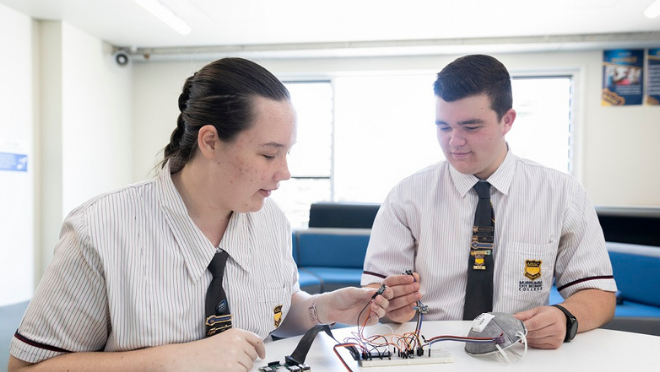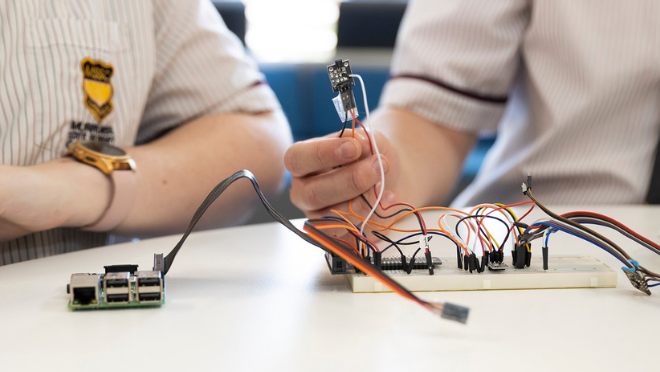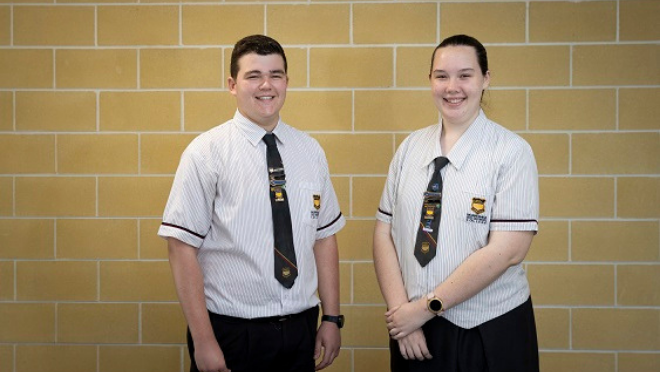Youth Innovation Award winner continues product development
Youth Innovation Award winner continues product development
Murrumba State Secondary College’s Tiarna McElligott wants to protect firefighters from overexertion and has joined forces with another student to develop technology to do just that.
The award-winning concept continues to evolve 12 months on from winning her the 2019 Think2Be Youth Innovation Excellence Award at the Moreton Bay Region Business Excellence and Innovation Awards.
With COVID-19 ruling out this year’s awards, we’re shining a light on superstars from previous years and asking … what are they up to now?
Moreton Daily caught up with Tiarna, as the school year was drawing to a close, to check in on the progress of her IntelVest – a vest to measure firefighters’ physical distress while on the job.
Since winning the award in 2019 for the concept, Tiarna has teamed up with fellow student Owen Ventre to change the prototype from a vest to a mask after consultation with firefighters.

Where did Intelvest start?
Tiarna says she came up with the idea in March 2019, when she was working on a wearable technologies project in her engineering class. Initially, she was concerned about dangerous gasses, but learned after speaking with firefighters that these were accounted for with breathing apparatus.
Overexertion was more of an issue because often crews didn’t know members were in physical distress until they collapsed.
“The vests they wear keep the heat out so well, that it keeps their own heat in and then they overheat,” Tiarna explains.
“It’s obviously such a physically-taxing job that they end up getting completely overexerted and there’s not really a way to deal with that at the moment.
“So, the idea developed from there into ‘OK we need to track their temperature, heart rate and different factors like that’. I had a different prototype that was going to sit inside a vest.”
Further exploration revealed a mask would be a better way to measure temperature and heart rate, and the concept has continued to evolve.
Owen joined the project at the beginning of this year and since then the pair has taken the idea from theory to a prototype.
He and Tiarna are part of the Innovations Project at Murrumba State Secondary College where students work on a business idea from start to finish over a two-year period.
Students have the chance to take part in advisory boards, ‘shark tanks’, market stalls and problem-solving challenges, while also completing a Certificate III in Micro Business Operations/New Business and Entrepreneurship.

Learning from the experts
During consultation with firefighters at Taigum and Ashgrove fire stations, Tiarna and Owen learned how firefighting personal protective equipment is used.
“We learned how their masks worked and how the boards and systems they used worked and through that we got a clear idea of what the true issue was,” Owen explains.
“If a firefighter overexerts there is nothing to actually indicate that other than the fact that at a certain point, around 19 seconds, a loud alarm goes off to indicate that the firefighter has stopped moving and progressively gets louder into 30-40 seconds.
“We came to understand the psychology of the firefighters more – what will get them out of the building - and we came to the conclusion that the only way you’d get a firefighter out of the building, if they were going to overexert, was if they had someone tapping them on the back to replace them in that moment.”
Tiarna agrees: “If there’s someone stuck in that building, they won’t stop. They won’t say I need to leave, they’ll just keep going until they collapse and then there are two people to save”.
How does the innovative technology work?
“It uses a Raspberry Pi, which is basically a mini-computer that you can use in a computer chip and that connects into a heart rate sensor which we put in the cheek of the mask and we have a temperature sensor that can basically detect when they are breathing out and breathing in,” Tiarna explains.
“We can use that to figure out their respiratory rate, their heart rate, get an indication of whether their body temperature is increasing and different factors like that to determine overexertion and their risk of overexertion.
“We’re still figuring out exactly how that’s being sent out to control but we’re thinking it will be sent out to a connection that’s going to be on the BA (Breathing Apparatus) entry officer’s board which controls who goes in and who goes out.
“That will alert them that they need to tell the crew commander this team needs to come out or they’ve got three minutes and they need to be out of there. It will work in with their existing systems.”
Their prototype is a standard mask, but they are working on designs to work in existing firefighter masks.

Further development and investment
“It’s mainly been about meeting the right people who can help us. We need to continue to collect data, develop this model to as strong as it can possibly be and then at some point approach someone … potentially investment in the future,” Owen says.
Tiarna said: “We’re hoping to continue the development of the prototype and figure out how it’s going to work and I think we’re considering trying to partner with the university to be able to … obviously we’re going to need data of what points are they actually going to be overexerted.
“Sure, you can measure the heart rate but what heart rate is dangerous? So, monitoring with some sort of research facility … If it’s determined to be a medical technology, it’s going to need a lot of certification which will need to be implemented.”
In the meantime, the pair will continue to work on the project during the Christmas holidays